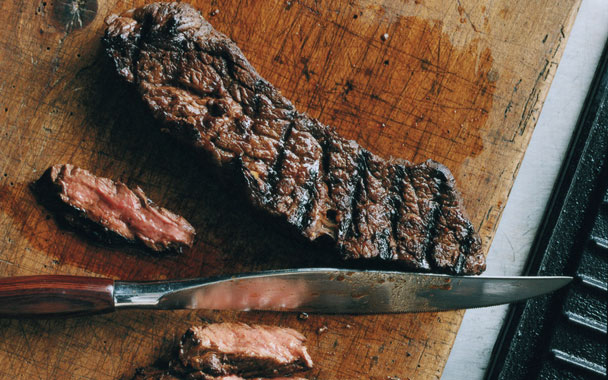One morning last July, I found myself combing the meat aisle of the supermarket. I was vacationing in northern New Hampshire, and I was looking for one of my favorite cuts of meat: skirt steak. I would even have settled for flank steak, but no such luck. So I buzzed for a butcher. “We don’t see skirt steak up here,” she told me, “and we don’t get much flank either, but people really like these sirloin tips.” They didn’t look promising. The long, ragged strips of loose-grained meat weren’t what I had in mind. I bought them anyway, thinking I should at least try them for research purposes.
Back at the house, I marinated them with a mixture similar to the one in food editor Ian Knauer’s Grilled Marinated Sirloin Flap Steaks recipe, and then grilled them. My family’s feedback was unanimous—these were the best steaks they could remember. The platter of meat was decimated in seconds.
The first thing I did when I got back home to Manhattan was to see if sirloin tips had been in my neighborhood markets all along. Neither my corner butcher shop nor my supermarket knew what I was talking about. To find out why, I called the National Cattlemen’s Beef Association.
I spoke to beef industry consultant Antonio Mata, a self-described “meat geek” with a doctorate in meat science. According to him, the term “sirloin tips” is loosely used and very confusing. Mata explained that what I’d bought in New Hampshire were steaks cut from the sirloin flap, the tail section of porterhouses and T-bones, which is different from the sirloin tip, which comes from the knuckle. Since the words “flap meat” and “knuckle” don’t conjure images of delicious, juicy steak, it’s only natural that butchers got creative with names. (Mata says the pricier parts of the steer—New York strips and Delmonico steaks—got all the good names.)
So the New England moniker for sirloin flap is “sirloin tips.” In New York City, a popular butcher named the uncut sirloin flap “Bohemian steak,” and the restaurant Elettaria calls the same thing a “bavette steak.” Better yet, a butcher shop in the northern New Hampshire town of Berlin sells flap meat as “grill candy.” Who can resist that? Rudy, the owner, told me it was his idea. He knew that sirloin flap was an underappreciated cut of beef, so he sliced it into thin strips, immersed it in a doctored-up bottled marinade, and re-branded it.
Rudy’s creative efforts reminded me of my favorite butcher, the late Jack Ubaldi. My first encounter with him—or, more accurately, his steak—was through my then-boyfriend (now husband), who, years ago, presented me with a package of meat from a butcher shop near his loft apartment. “I got you some Newport steaks,” he announced excitedly. “They’re supposed to be really good. The guy behind the counter says Mayor Ed Koch buys them all the time. And they’re pretty cheap.”
I’d never seen steak quite like it before. Each curved triangular piece had a distinct grain and cherry-red flesh, so different from the deep purple-red of skirt and hanger steaks. I pan-seared my gift on my date’s tiny stove, and we feasted on surprisingly tender steaks with a lot of beefy flavor.
About a year later, during a class on meat at The New School, my teacher (and adoptive Italian grandfather) Jack Ubaldi mentioned Newport steaks. Jack, a short, stocky fellow with a heart as big as the smile that barely left his face, was the owner and butcher of New York City’s Florence Meat Market. One night, after we had cleaned the work tables and poured some wine, Jack told us the story behind Newport steaks. Apparently, the name “Newport steak” was his invention. As a neighborhood butcher, he thought the triangular muscle from the sirloin (now commonly known as tri-tip roast) looked promising with its good marbling, so he cut it across the grain into steaks that looked like croissants. But what to call it? Jack’s lightbulb moment came while he was watching a Newport cigarette commercial. In the screen’s upper corner was a logo that looked like a boomerang, the same shape as his new cut of steak. “That’s it,” he decided, “Newport steaks.”
Fast forward to the spring of 2008 when food editor Ian Knauer began developing recipes for our October feature on butcher cuts. I told Ian about Newport steaks, but I hadn’t bought any in a long time. I called the Florence Meat Market and learned that although Jack Ubaldi passed away years ago, the store still sells Newport steaks. And, according to a friend, Ottomanelli’s Meat Market in Greenwich Village sells them too. Intrigued, I called Frank Ottomanelli and asked if he knew the origin of the name. “I think it’s from Newport, Rhode Island,” he said, “You know, the shape of it.” True, that story could work; Newport’s harbor has the same curve. But I bet it’s the cachet of the nineteenth-century moneyed class and their grand Newport “cottages” that the name conjures in most people’s minds. Did Jack Ubaldi think about that when he zeroed in on the cigarette logo? I like to think he did.


